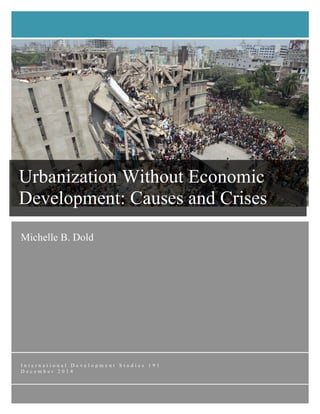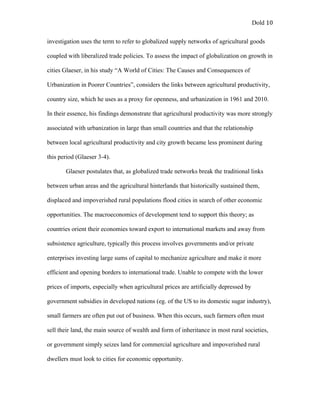This document discusses urbanization trends globally and examines why some countries have undergone rapid urbanization without corresponding increases in GDP per capita. It notes that while cities were historically symbols of wealth and power, many of today's largest megacities have emerged in developing countries without significant economic growth. Maps and data from the UN show urban growth rates over 3% concentrated in Asia and Africa since 1990. The top contributors to projected urban population increases by 2050 will be China, India, Nigeria and other developing nations across a wide range of income levels. This suggests urbanization has become decoupled from national wealth, with potential risks for poor megacities lacking strong institutions.



![Dold 4
European continent. During this period, high growth rates of 3% or more were
concentrated almost exclusively in Asia and Africa, a trend that demographers predict
will continue in coming decades.
Figure
1:
Growth
Rates
of
Urban
Agglomerations,
1970-‐1990
[United
Nations
World
Urbanization
Prospects:
2014
Revision]
Figure
2:
Growth
Rates
of
Urban
Agglomerations,
1990-‐2000
[United
Nations
World
Urbanization
Prospects:
2014
Revision]
City Population
500 - 750 thousand
750 - 1000 thousand
1-5 million
5-10 million
10 million or more
Growth Rate
× <1%
× 1-3%
× 3-5%
× 5% +
Note: Designations employed and the presentation of material on this map do not imply the expression of any opinion whatsoever on
the part of the Secretariat of the United Nations concerning the legal status of any country, territory or area, or of its authorities,
or concerning the delimitation of its frontiers or boundaries.
City Population
500 - 750 thousand
750 - 1000 thousand
1-5 million
5-10 million
10 million or more
Growth Rate
× <1%
× 1-3%
× 3-5%
× 5% +
Note: Designations employed and the presentation of material on this map do not imply the expression of any opinion whatsoever on
the part of the Secretariat of the United Nations concerning the legal status of any country, territory or area, or of its authorities,
or concerning the delimitation of its frontiers or boundaries.](https://image.slidesharecdn.com/8526dae2-d5cd-49c8-9602-e04715581ed9-150105215310-conversion-gate01/85/TERM-PAPER-4-320.jpg)
![Dold 5
The following graph (Figure 3) from the United Nations’ World Urbanization
Prospects 2014 Revision illuminates in more detail what can be gleaned from the maps
above: that the greatest contributors to growth in the urban population in the coming
decades will be from Asia and Africa, especially from exceptionally rapidly urbanizing
countries such as China, India, Nigeria, and Indonesia. Excluding the United States,
North American and European countries are notably missing from the list. Perhaps the
most striking takeaway from
the graphic is that the greatest
contributors to urban growth
will be from a massive range
of income brackets- from the
US with a 2013 per capita
income of $53,143 to Nigeria
with a GDP per capita of
$3,006 to the Democratic
Republic of the Congo, whose
average income was just $454
in 2013 (World Bank). The
graphs below (Figures 4 and 5) further substantiate this notion of a loosening correlation
between a nation’s wealth and its level of urbanization. One can observe the relationship
between percentage urban on the y-axis and purchasing power parity-adjusted income per
capita on the x-axis transform from a somewhat tight positive linear pattern, suggesting
that richer countries tended to be more urban in 1960, to a more cloud-like shape,
World Urbanization Prospects: The 2014 Revision12
Just a few countries are home to half of the world’s urban population. China has
the largest urban population (758 million), followed by India (410 million). These two
countries account for 30 per cent of the world’s urban population and, with another five
countries, the United States of America (263 million), Brazil (173 million), Indonesia (134
million), Japan (118 million) and the Russian Federation (105 million), account for more
than half of the world’s urban population.
Future increases in the world’s urban population are also expected to be highly con-
centrated in just a few countries (figure 7). Taken together, China, India and Nigeria are
projected to account for 37 per cent of the increase of nearly 2.5 billion people in the urban
population by 2050. Between 2014 and 2050, the urban areas are expected to grow by 404
million people in India, 292 million in China and 212 million in Nigeria. Seven other
countries, the Democratic Republic of Congo, Ethiopia, the United Republic of Tanzania,
Bangladesh, Indonesia and Pakistan, and the United States of America, are projected to
contribute more than 50 million each to the urban increment and will constitute together
another 20 per cent of the total increase in urban population. In a few countries, the urban
population will decrease, despite projected increases in the level of urbanization. The larg-
est declines between 2014 and 2050 are projected for Japan, with a decline of 12 million
urban dwellers and for the Russian Federation, expected to decline by 7 million.
Figure 7.
Contribution to the increase in urban population by country, 2014 to 2050
China and India will
contribute more than
one third of the global
urban population
increase between 2014
and 2050
Note: The countries shown are projected to contribute 25 million or more to the global urban increment
between 2014 and 2050. The category “Other countries” includes countries with urban increments
of less than 25 million each.
0
500
1000
1500
2000
2500
Other countries
Democratic Republic of the Congo
China
India
nearly 2.5 billion
urban population increase
by 2050
50%
Nigeria
Indonesia
United States of America
Pakistan
Urbanpopulationincrease(millions)
Iraq
Angola
Viet Nam
Sudan
Iran (Islamic Republic of)
Uganda
Kenya
Egypt
Mexico
Brazil
Philippines
Ethiopia
United Republic of Tanzania
Bangladesh
Figure
3:
Contribution
to
the
Increase
in
Urban
Population
by
Country,
2014-‐2050
[United
Nations
World
Urbanization
Prospects:
2014
Revision]](https://image.slidesharecdn.com/8526dae2-d5cd-49c8-9602-e04715581ed9-150105215310-conversion-gate01/85/TERM-PAPER-5-320.jpg)
![Dold 6
suggesting that by 2011 wealth was no longer a requisite nor a guaranteed outcome of
urbanization. Osaka, Japan, for example, one of the wealthiest megacities, is projected to
fall from its former place as second largest city in 1990 to the thirteenth largest city in
2030, whereas demographers predict that Lagos, Nigeria will grow to become the ninth
largest city in 2030 from its position as thirty-third in 1990 (United Nations). As the
association between urbanization and average income slackens, lower living standards in
emerging poor megacities are inciting debate within academia and popular discourse over
whether governments should adopt policies that encourage or abate urbanization in their
countries.
Figure
4:
GDP
per
Capita
vs.
Urban
Population
(%
of
Total),
1960
[Gapminder
World]](https://image.slidesharecdn.com/8526dae2-d5cd-49c8-9602-e04715581ed9-150105215310-conversion-gate01/85/TERM-PAPER-6-320.jpg)
![Dold 7
Figure
5:
GDP
per
Capita
vs.
Urban
Population
(%
of
Total),
2011
[Gapminder
World]
III. Positive and Negative Externalities of Urbanization
The process of absorbing rural migrants into cities includes both positive and
negative externalities, which in economics are defined as “situations in which the private
costs or benefits to the producers or purchasers of a good or service differs from the total
social costs or benefits entailed in its production and consumption” (Johnson). There are
well-known and well-researched benefits to urbanization, especially with regards to
industry, as a concentration of economic agents tends to increase productivity via
agglomeration economies. In the 1960s, urban planner Jane Jacobs characterized cities as
incubators of innovation and knowledge spillovers resulting from the collision of many
people with diverse educational backgrounds and skillsets (Rigby). However, a focus on
these assumed benefits of urbanization, sometimes referred to in the literature as the](https://image.slidesharecdn.com/8526dae2-d5cd-49c8-9602-e04715581ed9-150105215310-conversion-gate01/85/TERM-PAPER-7-320.jpg)












